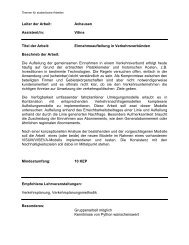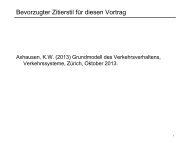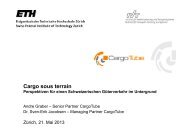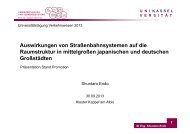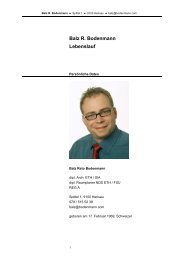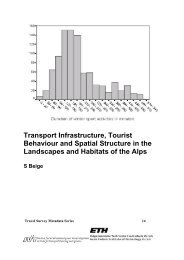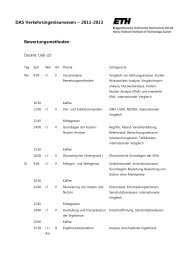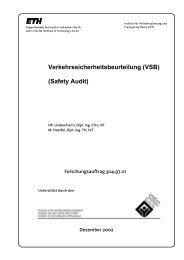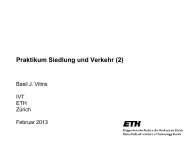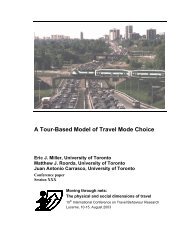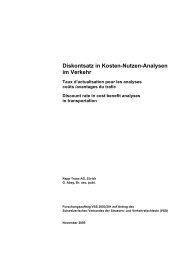Download - IVT - ETH Zürich
Download - IVT - ETH Zürich
Download - IVT - ETH Zürich
Erfolgreiche ePaper selbst erstellen
Machen Sie aus Ihren PDF Publikationen ein blätterbares Flipbook mit unserer einzigartigen Google optimierten e-Paper Software.
Projekte am <strong>IVT</strong><br />
Beurteilung von Tramfahrzeugtypen bezüglich Fahrgastfluss<br />
Bearbeiter am <strong>IVT</strong>, Gruppe IV, VS: U. Weidmann, U. Kirsch, S. Höppner; Auftraggeber: Siemens Schweiz AG;<br />
Laufzeit: 04/2012 bis 07/2012<br />
Calibration Study for VISSIM<br />
Bearbeiter am <strong>IVT</strong>, Gruppe SVT: M. Menendez, Q. Ge; Auftraggeber: Modelling and Simulation group within<br />
the Division of Transport for the City of Zurich; Laufzeit: 06/2011 bis 09/2012<br />
The City of Zürich acquired “Verkehr In Städten – SIMulationsmodell” (VISSIM), a microscopic multi-modal<br />
traffic flow simulation software, to effectively model traffic within the city. VISSIM is a widely used simulation<br />
software with many applications and high potential. However, like other commercial microscopic<br />
traffic simulation software, VISSIM has a big number of input parameters (currently it has 192 parameters)<br />
which makes the process of calibration rather difficult. In addition, the spatial scope of the network being<br />
modelled was quite large, as even the initial network encompassed the inner city of Zürich (a complex urban<br />
layout with narrow streets, hills, mixed transportation modes, a large amount of pedestrians, etc.).<br />
The objective of this project was to optimize the calibration process, so the City of Zürich could calibrate<br />
the VISSIM model in the most efficient way, tailored to its specific needs and requirements.<br />
In the first phase, we evaluated the functions and capabilities of VISSIM, investigated the city characteristics<br />
for software implementation, and reviewed the calibration procedures (advantages and drawbacks)<br />
from the literature.<br />
In the second phase we conducted a sensitivity analysis to identify the most influential parameters for<br />
VISSIM calibration. It started with a qualitative understanding and preliminary identification of the 182 relevant<br />
parameters based on Zürich inner city’s traffic conditions and other characteristics. Based on that,<br />
further screening of 14 parameters was performed based on a review of existing literature, common sense<br />
and own experience. We developed an improved screening approach based on the Elementary Effects Method<br />
(the quasi-OTEE method), and this approach was used to pick the 6 most influential parameters for<br />
the calibration in the last step.<br />
The last phase was the model calibration. This phase, performed in conjunction with personnel from the<br />
Division of Transport at the City of Zürich, used real data to calibrate the model. Travel time measurement<br />
from TomTom data and traffic volumes from loop detectors were employed in the calibration of the model.<br />
A pattern search algorithm was used to optimize the calibration process.<br />
Continuous Need-Based Planning for Efficient Agent-Behavior Modeling<br />
Bearbeiter am <strong>IVT</strong>, Gruppe VP: D. Charypar, F. Märki; Auftraggeber: SNF; Laufzeit: 01/2009 bis 01/2012<br />
In diesem Projekt wurde ein Modell der Aktivitätenplanung entwickelt, das insbesondere auf den andauernden<br />
Planungs-Prozess abzielt, welcher auch während der Ausführung von Aktivitäten stattfindet. Dies<br />
wurde erreicht, indem die Agenten, welche in vielen unserer Modelle Anwendung finden, um einen inneren<br />
Zustand erweitert wurden. Dieser Zustand bildet unter anderem die Bedürfnisse der Personen ab, wie<br />
z. B. Das Bedürfnis zu schlafen und zu essen, zu arbeiten und nach Erholung. Aufgrund der Bedürfnisse wird<br />
dann entschieden, welche Aktivität als nächste ausgeführt werden soll.<br />
Die Annahme bei dieser Auswahl ist es, dass Personen sich mehr oder weniger für diejenige Aktivität entscheiden,<br />
welche gerade die grösste Befriedigung der Bedürfnisse verspricht. Umgekehrt wird ein dringendes<br />
Bedürfnis, das unbefriedigt bleibt als stark negativ bewertet. Der Nutzen von Handlungen wird aber<br />
nicht explizit optimiert, sondern heuristisch angestrebt. Durch Verzicht auf einen Optimierung des Nutzens,<br />
konnte dabei ein grosser Geschwindigkeitszuwachs erzielt werden.<br />
Das entstandene Modell wurde anhand von bereits vorhandenen Befragungsdaten getestet: Einerseits<br />
wurde versucht auf Basis der Beobachtungen die Parameter für das Modell abzuleiten, andererseits wurde<br />
das so erhaltene Modell zur Simulation von synthetischen Tagesplänen verwendet. Nach einigen Erweiterungen,<br />
z. B. um ein Modell der Öffnungszeiten und der Präferenz von gewissen Aktivitäten für bestimmte<br />
Tageszeiten, zeigte sich, dass generell die Übereinstimmung zwischen Realität und Simulation und gut ist,<br />
allerdings besteht eine gewisse Schwäche bei der Erzeugung realistischer Abweichungen vom Norm-Verhalten:<br />
Generell kann man sagen, dass die generierten Pläne eher zu homogen sind und zu wenig (sinnvolle)<br />
Varianz zeigen.<br />
36 <strong>IVT</strong> Jahresbericht 2012



